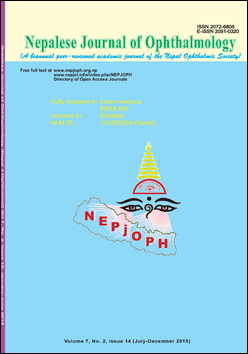Neurocysticercosis – A Window to Intraocular Involvement
DOI:
https://doi.org/10.3126/nepjoph.v7i2.14963Keywords:
Neurocysticercosis, Intraocular Cysticercosis, VitrectomyAbstract
Objective : To analyse the clinical characteristics of intraocular cysticercosis and the association of neurocysticercosis with intraocular involvement in these patients
Materials and methods: Retrospective case series of records of patients managed at a Tertiary Care Hospital in South India. Case records of patients managed at a Tertiary Care Hospital in South India over two years (October 2012 – October 2014) were reviewed and cases reported with intraocular cysticercosis were included in the study and results analyzed.
Results: Five (5) patients of intraocular cysticercosis were diagnosed in a two year period at our centre, 60% being bilateral. Eight (8) eyes of five (5) patients had intraocular cysts documented by clinical examination and B mode ultrasonography (75% eyes with active cysts, 25% eyes inactive) .Visual acuity at presentation of eyes with active cysts ranged from perception of light to counting finger 4m. The 75% eyes had tractional retinal detachment at presentation. Neurocysticercosis was documented in 80% of the cases oncomputed tomography / magnetic resonance imaging . Six (6) eyes with active cysts underwent parsplanavitrectomy with cyst removal using vitreous cutter with concurrent management of tractional retinal detachment in five (5) eyes. Postoperative visual recovery was poor in eyes with associated tractional retinal detachment while good anatomical outcome was achieved in all six (6) cases.
Conclusion: Intraocular cysticercosis can be associated with cysts in other areas. High number of patients with neurocysticercosis (80%) in those with intraocular cysticercosis in our study may indicate positive association between the two which needs further investigation.
Downloads
Downloads
Published
How to Cite
Issue
Section
License
This license enables reusers to copy and distribute the material in any medium or format in unadapted form only, for noncommercial purposes only, and only so long as attribution is given to the creator.




